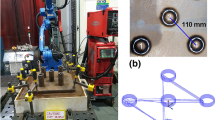Abstract
Wire electrochemical machining (WECM) is a potential method for manufacturing macrostructures from difficult-to-cut materials, such as turbine slots, with good surface integrity and low costs. In this study, a novel tube electrode with array holes in the front and insulation in the back was applied using WECM to improve the machining precision and efficiency. Additionally, assisted by an immersion electrolyte and axial flushing, the electrolyte-deficient gap was supplemented to achieve the cutting of a very thick workpiece. The simulation results indicated that this method could effectively reduce the machining gap and improve the uniformity of the electric- and flow-field distributions. Experiments verified that when the uninsulated range (machining angle) was reduced from 360° to 90°, the side machining gap was reduced from 462.5 µm to 175 µm. Finally, using optimized machining parameters, array slits with gaps as small as (175±10) μm were machined on a powder superalloy René 88DT sample with a thickness of 10 mm at a feed rate of 16 µm/s. The feasibility of fabricating complex profiles using this method was verified using a self-designed servo device.
























Similar content being viewed by others
References
Chamanfar A, Monajati H, Rosenbaum A et al (2017) Microstructure and mechanical properties of surface and subsurface layers in broached and shot-peened Inconel-718 gas turbine disc fir-trees. Mater Charact 132:53–68
Axinte D, Boud F, Penny J et al (2005) Broaching of Ti-6-4—detection of workpiece surface anomalies on dovetail slots through process monitoring. CIRP Ann 54(1):87–90
Klocke F, Welling D, Dieckmann J et al (2012) Developments in wire-EDM for the manufacturing of fir tree slots in turbine discs made of Inconel 718. Key Eng Mater 504/506:1177–1182
Hang Y, Zeng Y, Yang T et al (2020) The dissolution characteristics and wire electrochemical micromachining of metallic glass Ni82Cr7Si5Fe3B3. J Manuf Processes 58:884–893
Kim BH, Na CW, Lee YS et al (2005) Micro electrochemical machining of 3D micro structure using dilute sulfuric acid. CIRP Ann 54(1):191–194
Sharma V, Patel DS, Jain VK et al (2018) Wire electrochemical threading: a technique for fabricating macro/micro thread profiles. J Electrochem Soc 165(9):E397–E405. https://doi.org/10.1149/2.1181809jes
Fang X, Zhang P, Zeng Y et al (2016) Enhancement of performance of wire electrochemical micromachining using a rotary helical electrode. J Mater Process Technol 227:129–137
Zeng Y, Yu Q, Wang S et al (2012) Enhancement of mass transport in micro wire electrochemical machining. CIRP Ann 61:195–198
Besekar N, Bhattacharyya B (2022) Experimental investigation and characterization of NiTinol shape memory alloy during wire electrochemical machining. J Manuf Processes 81:346–361
He H, Qu N, Zeng Y et al (2016) Machining accuracy in pulsed wire electrochemical machining of γ-TiAl alloy. Int J Adv Manuf Technol 86:2353–2359
He H, Zeng Y, Yao Y et al (2017) Improving machining efficiency in wire electrochemical micromachining of array microstructures using axial vibration-assisted multi-wire electrodes. J Manuf Processes 25:452–460
Debnath S, Masanta M, Bhattacharyya B (2022) Wire electrochemical machining employing newly developed tungsten micro wire with repeatedly similar cross sectional variations. J Manuf Processes 74:535–543
Maity S, Debnath S, Bhattacharyya B (2020) Modeling and investigation on multi-wire electrochemical machining (MWECM) assisted with different flushing strategies. J Manuf Processes 57:857–870
Klocke F, Herrig T, Zeis M et al (2018) Experimental investigations of cutting rates and surface integrity in wire electrochemical machining with rotating electrode. Procedia CIRP 68:725–730
Klocke F, Herrig T, Klink A (2018) Evaluation of wire electrochemical machining with rotating electrode for the manufacture of fir tree slots. Proc ASME Turbo Expo. https://doi.org/10.1115/GT2018-76910
Yang T, Zeng Y, Hang Y (2019) Workpiece reciprocating movement aided wire electrochemical machining using a tube electrode with an array of holes. J Mater Process Technol 271:634–644
Xu C, Fang X, Han Z et al (2020) Wire electrochemical machining with pulsating radial electrolyte supply and preparation of its tube electrode with micro-holes. Appl Sci. https://doi.org/10.3390/app10010331
Li BK, Miao Q, Li M et al (2020) An investigation on machined surface quality and tool wear during creep feed grinding of powder metallurgy nickel-based superalloy FGH96 with alumina abrasive wheels. Adv Manuf 8:160–176
Han Z, Fang X, Zeng Y et al (2022) Wire electrochemical trimming the recast layer on René 88DT for aero-engine applications. Electrochim Acta 418:140372. https://doi.org/10.1016/j.electacta.2022.140372
Pattavanitch J, Hinduja S, Atkinson J (2010) Modelling of the electrochemical machining process by the boundary element method. CIRP Ann 59:243–246
Chen X, Zhu J, Xu Z et al (2021) Modeling and experimental research on the evolution process of micro through-slit array generated with masked jet electrochemical machining. J Mater Process Technol 298:117304. https://doi.org/10.1016/j.jmatprotec.2021.117304
Zhou Z, Fang X, Zeng Y et al (2021) Research on machining gap distribution in wire electrochemical micromachining. J Electrochem Soc 168:043503. https://doi.org/10.1149/1945-7111/abf79c
Acknowledgments
This project was supported by the National Natural Science Foundation of China (Grant No. 51975291), the Science Center for Gas Turbine Project (Grant No. P2022-B-IV-010-001), and the Natural Science Foundation of Jiangsu Province (Grant No. BK20191279).
Author information
Authors and Affiliations
Corresponding author
Rights and permissions
Springer Nature or its licensor (e.g. a society or other partner) holds exclusive rights to this article under a publishing agreement with the author(s) or other rightsholder(s); author self-archiving of the accepted manuscript version of this article is solely governed by the terms of such publishing agreement and applicable law.
About this article
Cite this article
Tang, C., Han, Z., Zhou, ZQ. et al. Precision wire electrochemical machining of thick structures in powder superalloy René 88DT using a partially insulated tube electrode. Adv. Manuf. 11, 618–635 (2023). https://doi.org/10.1007/s40436-023-00441-5
Received:
Revised:
Accepted:
Published:
Issue Date:
DOI: https://doi.org/10.1007/s40436-023-00441-5




